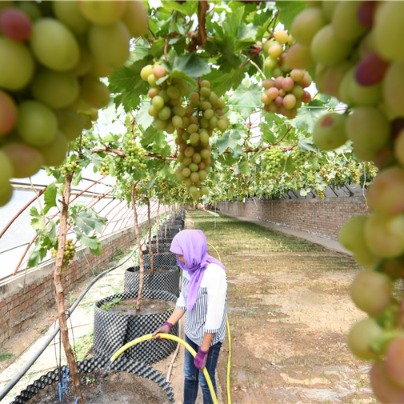



Fans of popular TV series boost tourism in the area by visiting the show's shooting locations.
Along the street of Minning town in the Ningxia Hui autonomous region, Huang Yuqin was busy selling her homemade steamed buns and wild vegetables to tourists during the May Day holiday.
She says crowds of people have been flocking to the town after the television series Minning Town made a stir across the country earlier this year. Now, the street where she runs her business welcomes about 2,000 visitors a day.
"When I first moved here, there was nothing but the Gobi Desert. It was always windy and dusty. Several families lived in big holes dug on the dunes," says the 72-year-old. "There was not even one place to escape sandstorms."
Over the last two decades, drastic changes took place in the town with the central government's policies. Fujian province, a relatively developed coastal region which is more than 2,000 kilometers away, gave full support for funds, investment, job opportunities and human resources to Minning town to improve the harsh living environment and reduce poverty.

Once deemed "one of the least livable lands for human beings", Minning town has turned into a fully modern and urbanized community and has even become a hot spot for rural tourism this year after the popular TV series.
Minning Town received a score of 9.3 out of 10 on major box-office tracker Maoyan's website. Many viewers were captivated by the story of Ma Defu, the young, handsome and rough-skinned heroic Party secretary of the village. Together with other people, Ma helps villagers to build houses in the desert and make their "first bucket of gold" by growing mushrooms. He also encourages unemployed women to work at electronic factories in Fujian, and helps with the building of the town's own water supply station.
A netizen left a comment on the Maoyan website, writing that the show has touched viewers with stories very similar to reality, along with real emotions and vivid details.

"It tells how a village escapes poverty despite tremendous challenges, and how people realize their better selves after continuous struggles," writes the netizen.
Minning town is also a typical example of how China pushes forward poverty alleviation in rural areas and boosts cooperation between eastern and western areas in recent years.
During the five-day holiday, Minning town received more than 42,850 visitors, earning a total revenue of more than 450,000 yuan ($70,390). Before the TV series was aired, the local government says there were few visitors to the town.
Yang Ruihua, a 67-year-old tourist in Minning town, says he is obsessed with the TV drama. After watching it several times, Yang decided to see the town with his own eyes.
"He is excited to see the shooting locations and can even recite the lines," Jiang Huiqin, Yang's wife, says. "We grew up in villages too and it feels like traveling to the past."

Ji Fang, a primary school teacher, says she and her friends visited the town's mushroom production base and history museum.
"Its change is dramatic. Just like what's said in the TV series-'transformation from dried desert to golden sandy beach'. I can see the locals living much happier lives now," Ji says.
At the museum, Xie Xingchang, whom the character Ma Defu was modeled after, tells curious tourists that stories in the TV series are real, only that the reality is even more impressive than "reel life".
"The first day I came here, a sandstorm blew all my luggage away except for a wok and quilt," he says.
In real life, Xie and the villagers plant trees to block wind and sand, grow grapes and brew red wine, and sell mushrooms overseas. Rural women became livestreaming hosts, and the encroachment of the desert was beaten back.

Luo Qin, a tourist from Shaanxi province, tells China News Service that visiting the town is like watching a sequel of the TV drama.
"My favorite character is the young lady Bai Maimiao, and I met her equivalent in person today. She was promoted to be the workshop manager of a chateau. Stories about their rise above poverty are worth learning from," she says.
The town has designed seven tour routes for tourists to have a fully immersive experience. One spot on the routes is the yard of villager Zhao Hong, who has a character in the TV series modeled after him. Tourists go to Zhao's yard to take photographs of old items such as a tobacco pipe, a bicycle and a wheelchair. They were collected from villagers and used as props in the TV series.

Besides visiting the shooting locations, tourists can also pick grapes and raspberries, drink and brew red wine at a chateau, make handicrafts, have a barbecue and buy local agricultural specialties.
Zhao Chao, deputy Party secretary of the town, says it will further develop rural tourism with a combination of agricultural resources. It is also constructing a film and television themed site to let tourists learn about the history of the town in chronological order. It will also serve as a red tourism site and training center.
He says development of tourism will also create more jobs and income sources for locals. The number of tourists is expected to surpass 500,000 this year, with tourism revenue of up to 20 million yuan.


If you have any problems with this article, please contact us at app@chinadaily.com.cn and we'll immediately get back to you.